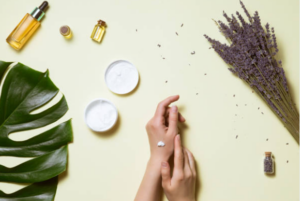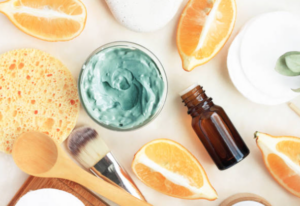From Cult Favorite to Mainstream

In the ever-evolving world of beauty, trends come and go like the changing seasons. One such trend that has been making waves in recent years is clean beauty. What started as a niche movement has now transformed into a mainstream phenomenon, with clean beauty brands taking center stage in the market. In this blog, we’ll delve into the fascinating journey of how clean beauty brands have gone from cult favorites to becoming integral parts of the beauty industry.
The clean beauty movement didn’t just happen overnight. It was born out of a growing concern among consumers about the ingredients lurking in their favorite skincare and cosmetics. This concern was fueled by a desire for transparency and a shift towards more natural, sustainable, and health-conscious living.
In the late 20th century, as scientific research began uncovering potential risks associated with certain synthetic chemicals commonly found in beauty products, a small but dedicated group of individuals decided to take matters into their own hands. These pioneers, including some passionate herbalists, chemists, and advocates for green living, started experimenting with crafting their own clean beauty formulations.
The early days of clean beauty were characterized by a do-it-yourself (DIY) ethos. Enthusiasts mixed and blended ingredients like essential oils, plant extracts, and clays in their kitchens, basements, and home laboratories. They swapped recipes and shared their creations within close-knit online communities and forums. This grassroots approach was driven by a desire to take control of what they put on their skin and hair.
The Rise of Social Media and Influencers
While the early days of clean beauty were marked by grassroots efforts and word-of-mouth recommendations, the movement truly gained momentum with the advent of social media. Platforms like Instagram, YouTube, and beauty-focused blogs provided a global stage for clean beauty brands and enthusiasts to connect, share, and inspire.
Instagram, with its visually oriented format, played a pivotal role in popularizing clean beauty. Clean beauty products, often featuring minimalist and aesthetically pleasing packaging, were perfectly suited for the platform’s image-driven nature.
Clean beauty enthusiasts, including bloggers, influencers, and everyday consumers, began showcasing their skincare and makeup routines on Instagram. They posted photos of their favorite clean beauty products, shared before-and-after shots, and provided detailed reviews. The hashtag #CleanBeauty quickly gained traction, creating a dedicated space for clean beauty discussions.
Instagram also allowed clean beauty brands to humanize their stories. They shared behind-the-scenes glimpses of product development, highlighted the sourcing of natural ingredients, and introduced the faces behind the brands. This transparency resonated with consumers who increasingly sought authenticity from the brands they supported.
YouTube, with its video-centric format, offered influencers the opportunity to create in-depth content about clean beauty. Beauty gurus and vloggers began posting tutorials, product reviews, and skincare routines centered around clean beauty products.
Influential beauty YouTubers like Tati Westbrook, Ingrid Nilsen, and Lisa Eldridge started featuring clean beauty brands in their videos. Their honest and relatable reviews provided valuable insights to their millions of subscribers, many of whom were eager to explore cleaner alternatives to conventional beauty products.
Additionally, clean beauty brands began collaborating with beauty influencers on YouTube to reach a broader audience. These partnerships often included sponsored content, product launches, and even co-created product lines, further cementing the connection between influencers and the clean beauty movement.

Retailers Take Notice
As clean beauty products gained popularity among consumers, major retailers began to take notice. Sephora, one of the world’s largest beauty retailers, launched a “Clean at Sephora” initiative, which curated a selection of products free from certain harmful ingredients. This move signaled a shift in the industry, acknowledging the demand for cleaner alternatives.
Other major retailers followed suit, creating dedicated clean beauty sections or labels within their stores. This increased visibility helped bridge the gap between niche clean beauty brands and mainstream consumers who might not have encountered them otherwise.
Clean beauty wasn’t just a trend limited to a single region; it became a global phenomenon. Consumers worldwide started seeking out clean beauty brands, and these brands responded by expanding their distribution networks internationally. This globalization allowed clean beauty to reach new markets and demographics, further cementing its position in the mainstream beauty industry.
The success of clean beauty brands caught the attention of investors and entrepreneurs. Venture capital began flowing into the clean beauty sector, enabling brands to scale up their operations, invest in research and development, and expand their product lines. This influx of capital led to even more innovation within the clean beauty space.
Clean beauty brands started to explore sustainable packaging options, reduce their carbon footprint, and experiment with cutting-edge natural ingredients. This commitment to sustainability appealed to environmentally conscious consumers, broadening the appeal of clean beauty even further.
As clean beauty continued to grow, the need for regulation and standardization became apparent. The lack of a universally accepted definition for “clean” or “natural” in the beauty industry led to consumer confusion and mistrust. To address this issue, organizations like the Environmental Working Group (EWG) and the Clean Beauty Collective emerged, offering guidelines and certification processes for clean beauty products.
These standards provided consumers with a clearer understanding of what clean beauty entailed and helped them make more informed choices. Furthermore, they added credibility to clean beauty brands, making it easier for them to navigate the complex beauty landscape.

The Future of Clean Beauty
As clean beauty continues its evolution from a niche trend to a dominant force in the beauty industry, several exciting developments and trends are poised to shape its future. Here are some key areas to watch:
1. Innovation in Ingredients
Clean beauty has always been synonymous with natural and non-toxic ingredients, but the future promises even more innovation in this regard. Expect to see clean beauty brands delving deeper into plant-based actives, rare botanicals, and sustainable alternatives to traditional ingredients. Research into the potency and benefits of lesser-known natural compounds will lead to novel formulations that address specific skincare concerns.
Additionally, clean beauty brands are likely to continue exploring biotechnology and green chemistry. This could result in the development of lab-grown ingredients that mimic the efficacy of natural substances without the environmental impact.
2. Sustainability at the Forefront
Sustainability has been a central pillar of the clean beauty movement, and it will only become more critical in the future. Clean beauty brands will intensify their efforts to reduce their environmental footprint. This includes not only using eco-friendly packaging but also adopting sustainable sourcing practices, ethical labor standards, and responsible manufacturing processes.
Look for brands to further emphasize their commitment to zero-waste initiatives, recyclability, and carbon neutrality. Initiatives like upcycling and closed-loop systems may also gain traction as brands strive for greater sustainability.
3. Customization and Personalization
Personalization is a growing trend in the beauty industry, and clean beauty won’t be an exception. Advances in technology, such as artificial intelligence and machine learning, will enable clean beauty brands to offer personalized skincare and makeup solutions.
Consumers may be able to access online platforms or apps that analyze their unique skin concerns and preferences. Based on this data, they’ll receive tailored product recommendations, allowing for a more individualized approach to clean beauty.
4. Inclusivity and Diversity
Diversity and inclusivity will take center stage in the clean beauty movement. Brands will expand their shade ranges to accommodate a broader spectrum of skin tones and types. Representation in marketing campaigns and product development will become more inclusive, ensuring that everyone feels seen and catered to by clean beauty brands.
Additionally, there will be a continued push for clean beauty to address the specific needs of various ethnicities and cultural backgrounds, recognizing that one-size-fits-all solutions are outdated and exclusionary.
5. Collaboration and Education
Clean beauty brands will increasingly collaborate with organizations, influencers, and experts to educate consumers and promote transparency. Expect to see more partnerships between brands and third-party certifying bodies or environmental organizations that advocate for sustainable practices.
Educational initiatives, workshops, and resources will become more widespread. Brands will empower consumers with knowledge about ingredient sourcing, product formulation, and the environmental impact of their choices. As a result, consumers will be better equipped to make informed decisions about the clean beauty products they use.
6. Regulatory Developments
The clean beauty industry may see further regulatory developments. Governments and regulatory bodies may introduce standardized definitions and guidelines for clean beauty, providing a clear framework for brands and consumers alike. This could help eliminate confusion and greenwashing in the industry.

7. Transparency Beyond Ingredients
Transparency has been a core value of clean beauty, but it will expand beyond just ingredient lists. Brands will increasingly share information about their supply chains, ethical labor practices, and sustainable sourcing efforts. Consumers will demand not only clean ingredients but also clean production processes.
In conclusion, the journey of clean beauty from a cult favorite to a mainstream phenomenon is a testament to the power of consumer demand, social media, and the commitment of visionary brands. As clean beauty continues to evolve, it will not only transform our beauty routines but also shape the future of the entire beauty industry, inspiring a cleaner, healthier, and more sustainable approach to self-care. So, whether you’re a dedicated clean beauty enthusiast or just curious about the movement, there’s never been a better time to explore the world of clean beauty and embrace the transformative power of natural ingredients.

